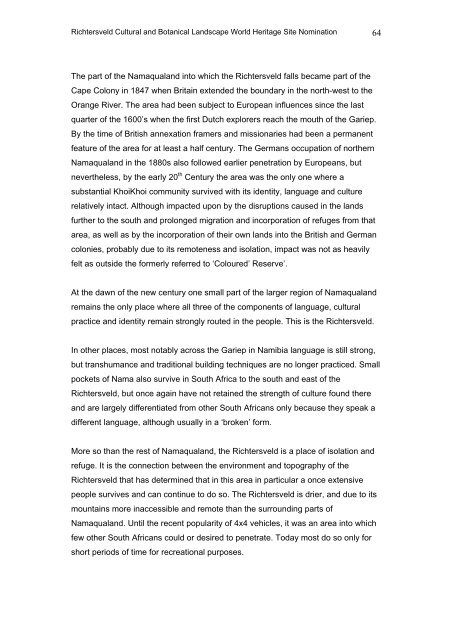the richtersveld cultural and botanical landscape - SAHRA
the richtersveld cultural and botanical landscape - SAHRA
the richtersveld cultural and botanical landscape - SAHRA
You also want an ePaper? Increase the reach of your titles
YUMPU automatically turns print PDFs into web optimized ePapers that Google loves.
Richtersveld Cultural <strong>and</strong> Botanical L<strong>and</strong>scape World Heritage Site Nomination 64<br />
The part of <strong>the</strong> Namaqual<strong>and</strong> into which <strong>the</strong> Richtersveld falls became part of <strong>the</strong><br />
Cape Colony in 1847 when Britain extended <strong>the</strong> boundary in <strong>the</strong> north-west to <strong>the</strong><br />
Orange River. The area had been subject to European influences since <strong>the</strong> last<br />
quarter of <strong>the</strong> 1600’s when <strong>the</strong> first Dutch explorers reach <strong>the</strong> mouth of <strong>the</strong> Gariep.<br />
By <strong>the</strong> time of British annexation framers <strong>and</strong> missionaries had been a permanent<br />
feature of <strong>the</strong> area for at least a half century. The Germans occupation of nor<strong>the</strong>rn<br />
Namaqual<strong>and</strong> in <strong>the</strong> 1880s also followed earlier penetration by Europeans, but<br />
never<strong>the</strong>less, by <strong>the</strong> early 20 th Century <strong>the</strong> area was <strong>the</strong> only one where a<br />
substantial KhoiKhoi community survived with its identity, language <strong>and</strong> culture<br />
relatively intact. Although impacted upon by <strong>the</strong> disruptions caused in <strong>the</strong> l<strong>and</strong>s<br />
fur<strong>the</strong>r to <strong>the</strong> south <strong>and</strong> prolonged migration <strong>and</strong> incorporation of refuges from that<br />
area, as well as by <strong>the</strong> incorporation of <strong>the</strong>ir own l<strong>and</strong>s into <strong>the</strong> British <strong>and</strong> German<br />
colonies, probably due to its remoteness <strong>and</strong> isolation, impact was not as heavily<br />
felt as outside <strong>the</strong> formerly referred to ‘Coloured’ Reserve’.<br />
At <strong>the</strong> dawn of <strong>the</strong> new century one small part of <strong>the</strong> larger region of Namaqual<strong>and</strong><br />
remains <strong>the</strong> only place where all three of <strong>the</strong> components of language, <strong>cultural</strong><br />
practice <strong>and</strong> identity remain strongly routed in <strong>the</strong> people. This is <strong>the</strong> Richtersveld.<br />
In o<strong>the</strong>r places, most notably across <strong>the</strong> Gariep in Namibia language is still strong,<br />
but transhumance <strong>and</strong> traditional building techniques are no longer practiced. Small<br />
pockets of Nama also survive in South Africa to <strong>the</strong> south <strong>and</strong> east of <strong>the</strong><br />
Richtersveld, but once again have not retained <strong>the</strong> strength of culture found <strong>the</strong>re<br />
<strong>and</strong> are largely differentiated from o<strong>the</strong>r South Africans only because <strong>the</strong>y speak a<br />
different language, although usually in a ‘broken’ form.<br />
More so than <strong>the</strong> rest of Namaqual<strong>and</strong>, <strong>the</strong> Richtersveld is a place of isolation <strong>and</strong><br />
refuge. It is <strong>the</strong> connection between <strong>the</strong> environment <strong>and</strong> topography of <strong>the</strong><br />
Richtersveld that has determined that in this area in particular a once extensive<br />
people survives <strong>and</strong> can continue to do so. The Richtersveld is drier, <strong>and</strong> due to its<br />
mountains more inaccessible <strong>and</strong> remote than <strong>the</strong> surrounding parts of<br />
Namaqual<strong>and</strong>. Until <strong>the</strong> recent popularity of 4x4 vehicles, it was an area into which<br />
few o<strong>the</strong>r South Africans could or desired to penetrate. Today most do so only for<br />
short periods of time for recreational purposes.

















